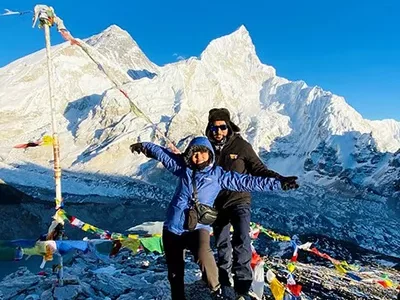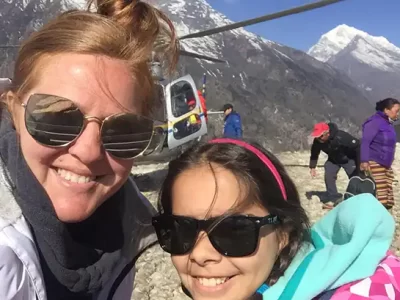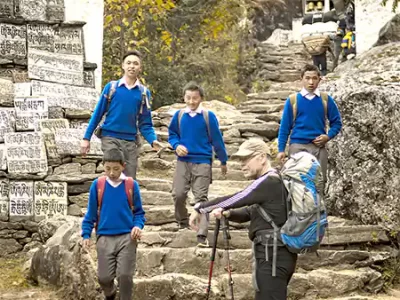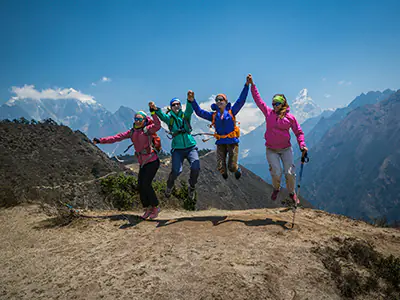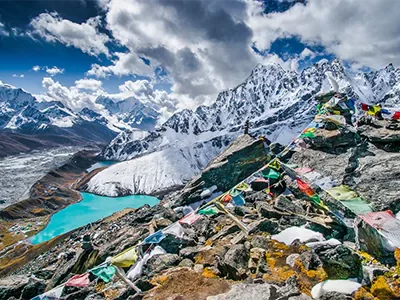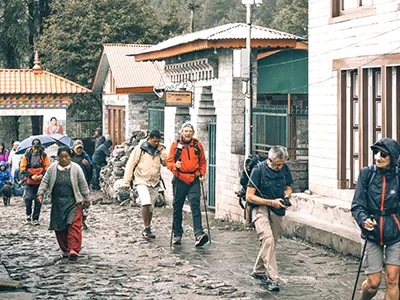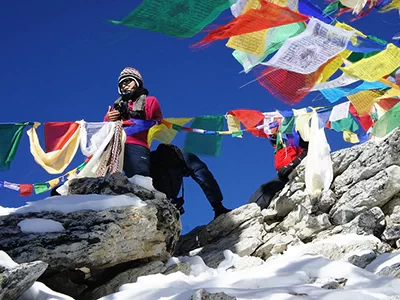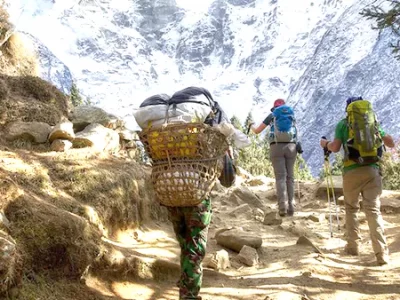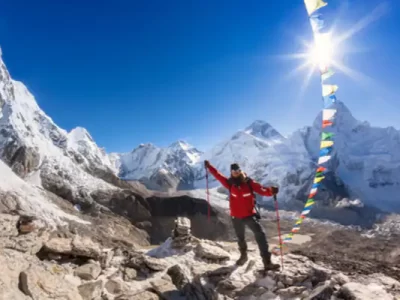The Everest Base Camp Trek in September is a highly anticipated adventure that draws in adventurers worldwide. This month is the ideal time for the Everest Base Camp Trek. As the monsoon season gradually retreats, September welcomes trekkers to the Everest region, presenting a harmonious blend of breathtaking landscapes, pleasant weather, and a serene ambiance.
1. The Allure of September: A Trekkers’ Delight
September holds a special place in the hearts of trekkers, and for good reason. This timeframe provides unique advantages, rendering it an ideal choice for individuals seeking an extraordinary Himalayan adventure.
a. Crystal Clear Skies: One of the most compelling reasons to choose September is the clear skies that grace the Everest region. The monsoon showers have cleansed the air, leaving behind pristine, unobstructed views of the towering peaks. Trekkers are treated to panoramic vistas of iconic summits like Mount Everest, Lhotse, and Ama Dablam, creating picture-perfect moments at every turn.
b. Mild Weather: September ushers in a milder climate in the Himalayas. While daytime temperatures are comfortably warm, the evenings bring a pleasant chill—ideal for a cozy evening by the teahouse fireplace. The moderate weather ensures your trek is enjoyable without the extremes of cold or sweltering heat.
c. Fewer Crowds: For those seeking a more serene trekking experience, September offers respite from the bustling crowds that often gather during the peak tourist seasons. Having fewer people on the trail enables you to experience the tranquility of the mountains, connect with nature, and immerse yourself in the awe-inspiring landscape.
d. Blooming Flora: September unveils a tapestry of colorful blooms as rhododendron forests burst into vibrant red, pink, and white shades. The rugged mountain backdrop is a captivating contrast to the lush greenery adorned with numerous wildflowers.
e. Ideal Photographic Conditions: Whether you’re an amateur photographer or a seasoned pro, the clear skies and stunning landscapes of September provide the perfect canvas for capturing the beauty of the Everest region. Each step of your journey presents an opportunity to capture unforgettable photographs.
Trekking to Everest Base Camp in September offers unparalleled natural beauty, comfortable weather, and solitude on the trail. It’s a time when the Himalayas unveil their grandeur, inviting you to immerse yourself in the breathtaking vistas and serene ambiance. Therefore, fasten your hiking boots, assemble your spirit of adventure, and prepare to commence the journey of a lifetime in the heart of the Everest region.
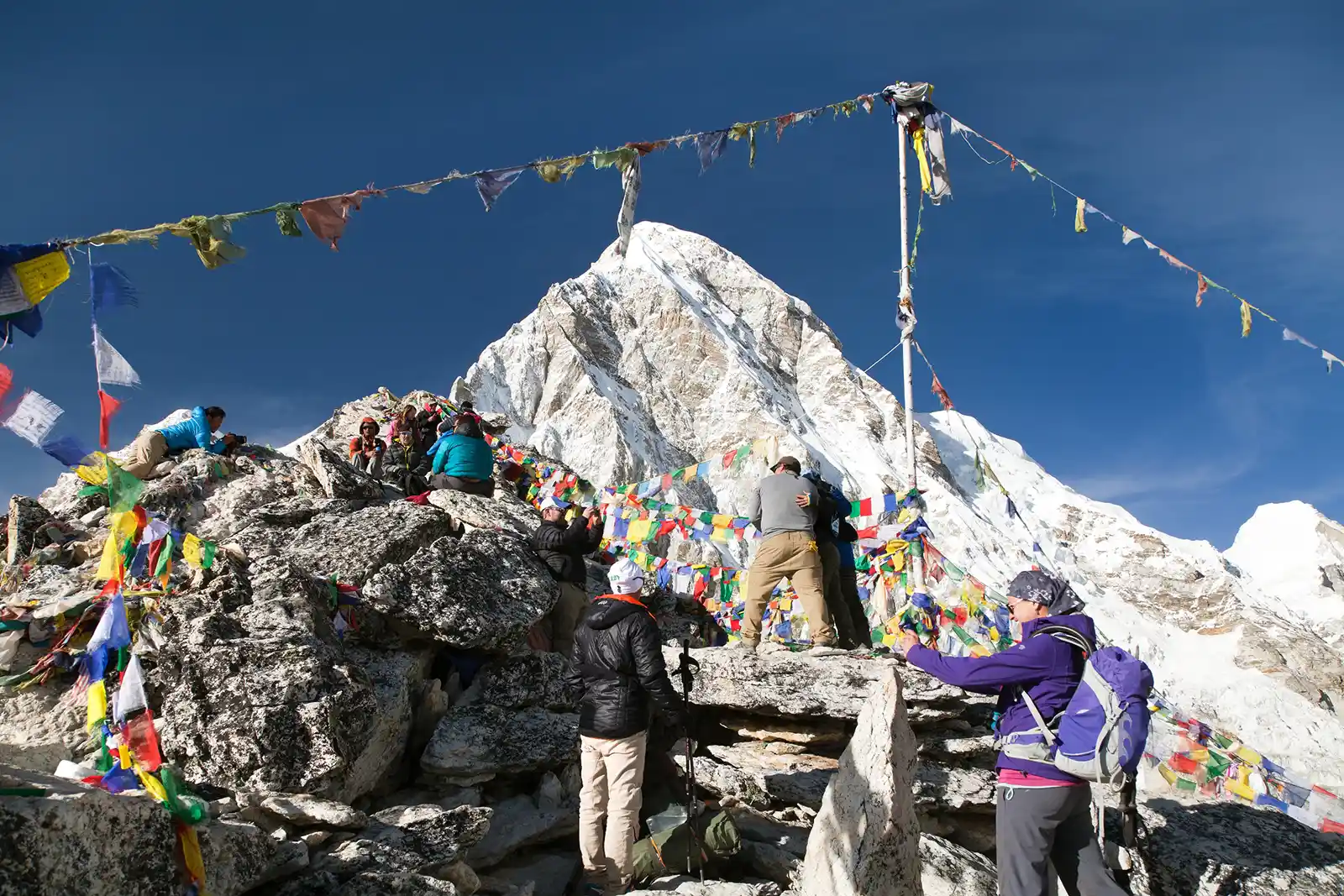
2. September Weather in the Everest Region: A Feast for the Senses
Trekking to Everest Base Camp in September promises a delightful blend of weather conditions ideal for a Himalayan adventure. However, it’s crucial to be prepared for variations that Mother Nature may throw your way, as the weather in the Everest region can be pretty dynamic.
Typical Weather Patterns:
Average Temperature: In September, daytime temperatures in the Everest region generally range from 10°C to 20°C (50°F to 68°F). These mild temperatures provide comfortable trekking conditions, allowing you to enjoy the journey without extreme heat or cold.
Rainfall: September signifies the conclusion of the monsoon season in Nepal. While the heavy rains have typically subsided by this time, occasional showers are still possible. Rainfall varies yearly, so carrying rain gear to stay dry in unexpected downpours is wise.
Humidity: As the monsoon withdraws, the humidity levels drop in September. Trekkers can expect relatively lower humidity than peak monsoon months, making the trek more comfortable.
Varied Weather Outlook:
It’s important to remember that the weather in the Everest region can be unpredictable, and conditions may change rapidly. While September generally offers favorable trekking weather, there’s always a chance of unexpected weather events. Trekkers should be prepared for:
Sudden Rain Showers: Although the monsoon is waning, isolated rain showers can still occur. It’s advisable to bring along a lightweight rain jacket or poncho to ensure you stay dry during these short rain showers.
Temperature Drops at Night: While daytime temperatures are pleasant, nights can get chilly, especially at higher altitudes. Packing warm clothing, including layers and a good-quality sleeping bag, is essential to stay cozy during cold nights.
Clear Skies with Exceptional Views: The defining feature of September is the crystal-clear skies that unveil the breathtaking mountain vistas. The views of Mount Everest and neighboring peaks are unparalleled during this time, making it a prime photography season.
September provides trekkers with a window of opportunity to experience the Everest Region in all its glory. While generally favorable, the weather can offer surprises, so packing a versatile wardrobe that includes both lightweight and warm clothing is essential. Be prepared to embrace the ever-changing mountain weather as you start a remarkable journey to Everest Base Camp.
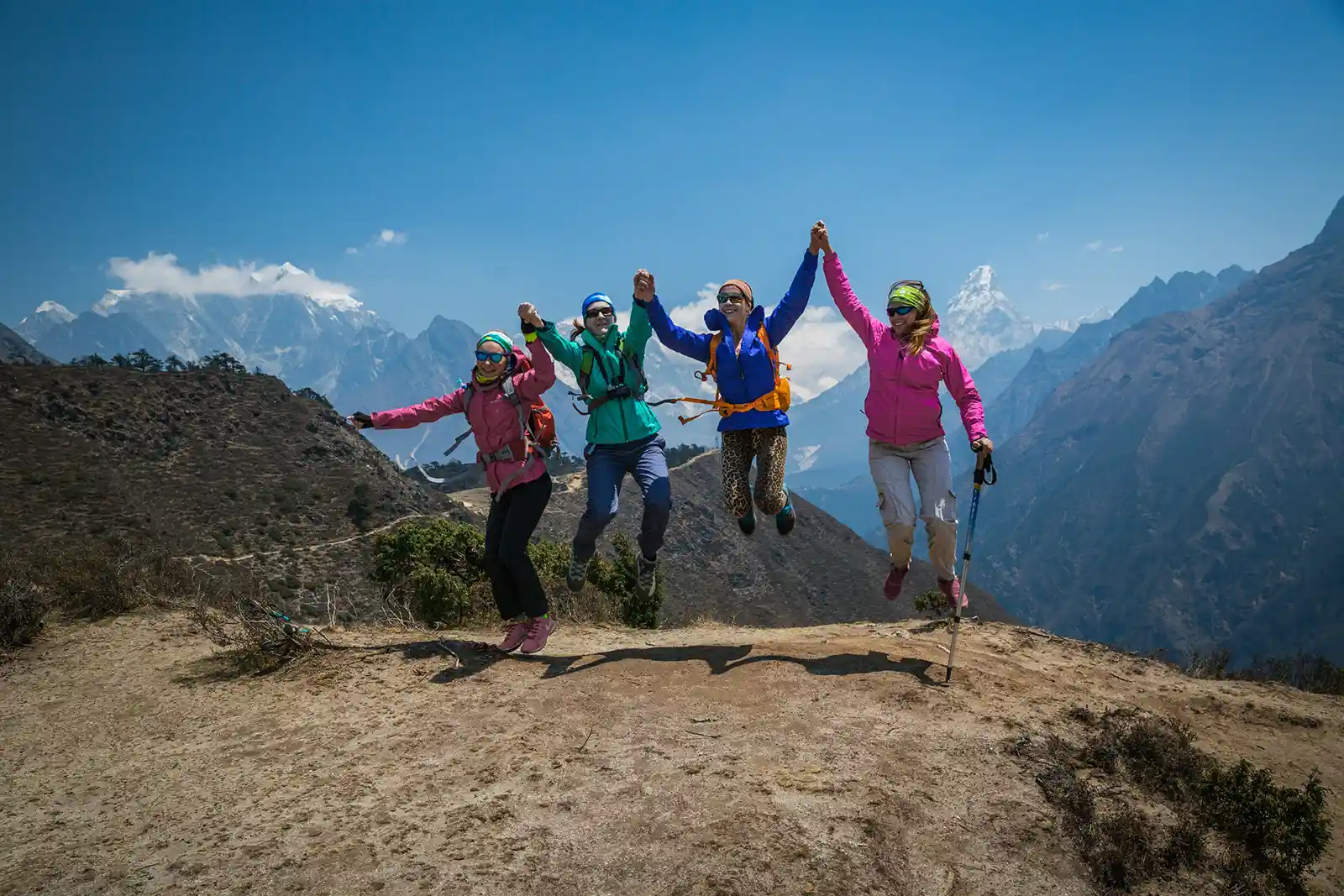
Everest Base Camp Trek
Everest Base Camp Trek with Helicopter Return
Everest Panorama Trek
3. Packing Smart for the Everest Base Camp Trek in September
Packing for the Everest Base Camp Trek in September requires careful consideration to ensure you have everything you need for a comfortable and safe journey. The items you carry should be versatile, weather-appropriate, and tailored to the unique demands of this iconic trek.
Clothing Essentials:
1. Moisture-Wicking Base Layers: Start with moisture-wicking base layers to keep sweat away from your skin. Opt for lightweight, quick-drying materials.
2. Insulating Layers: Layering is essential for changing temperatures. Pack a warm fleece or down jacket for chilly evenings and high altitudes.
3. Waterproof Jacket: Prepare for sporadic rain showers with a waterproof, breathable jacket to keep dry.
4. Trekking Pants: Choose comfortable, moisture-wicking, or convertible pants that adapt to different temperatures.
5. Trekking Shirts: Pack several moisture-wicking shirts for daily wear.
6. Headwear: A wide-brimmed hat or cap, a warm beanie, and sunglasses with UV protection are essential.
Footwear:
7. Hiking Boots: Invest in sturdy, waterproof hiking boots with good ankle support and break them in before your trek.
8. Socks: Bring moisture-wicking and warm socks. Consider a liner sock for added comfort.
9. Gaiters: These can help keep your boots dry in wet conditions and provide extra warmth.
Gear and Equipment:
10. Backpack: A comfortable, well-fitting trekking backpack is crucial. It should be large enough to carry your essentials but not too bulky.
11. Sleeping Bag: Choose a lightweight, cold-weather sleeping bag suitable for sub-zero temperatures.
12. Trekking Poles: These provide stability on steep descents and reduce the impact on your knees.
13. Headlamp: Essential for navigating teahouses and trails in the dark.
14. Water Purification: Bring a water purification system or iodine tablets to guarantee access to safe drinking water.
Medication and First Aid:
15. Altitude Medication: Consult your doctor and carry appropriate altitude sickness medication.
16. Basic First-Aid Kit: Include bandages, antiseptic wipes, pain relievers, and personal medications.
Miscellaneous:
17. Trekking Maps: Maps of the Everest region can be handy for navigation.
18. Electronics: A camera or smartphone for capturing memories and portable chargers.
19. Toiletries: Travel-sized toiletries, including biodegradable soap, toothbrush, and toothpaste.
20. Sunscreen: High SPF sunscreen to protect against the intense mountain sun.
Remember that packing light is key as you’ll be carrying your gear. Be selective with clothing and gear choices, and opt for functional, versatile, and well-suited items to changing weather conditions. The right packing strategy ensures you’re well-prepared to tackle the Everest Base Camp Trek in September comfortably and safely.
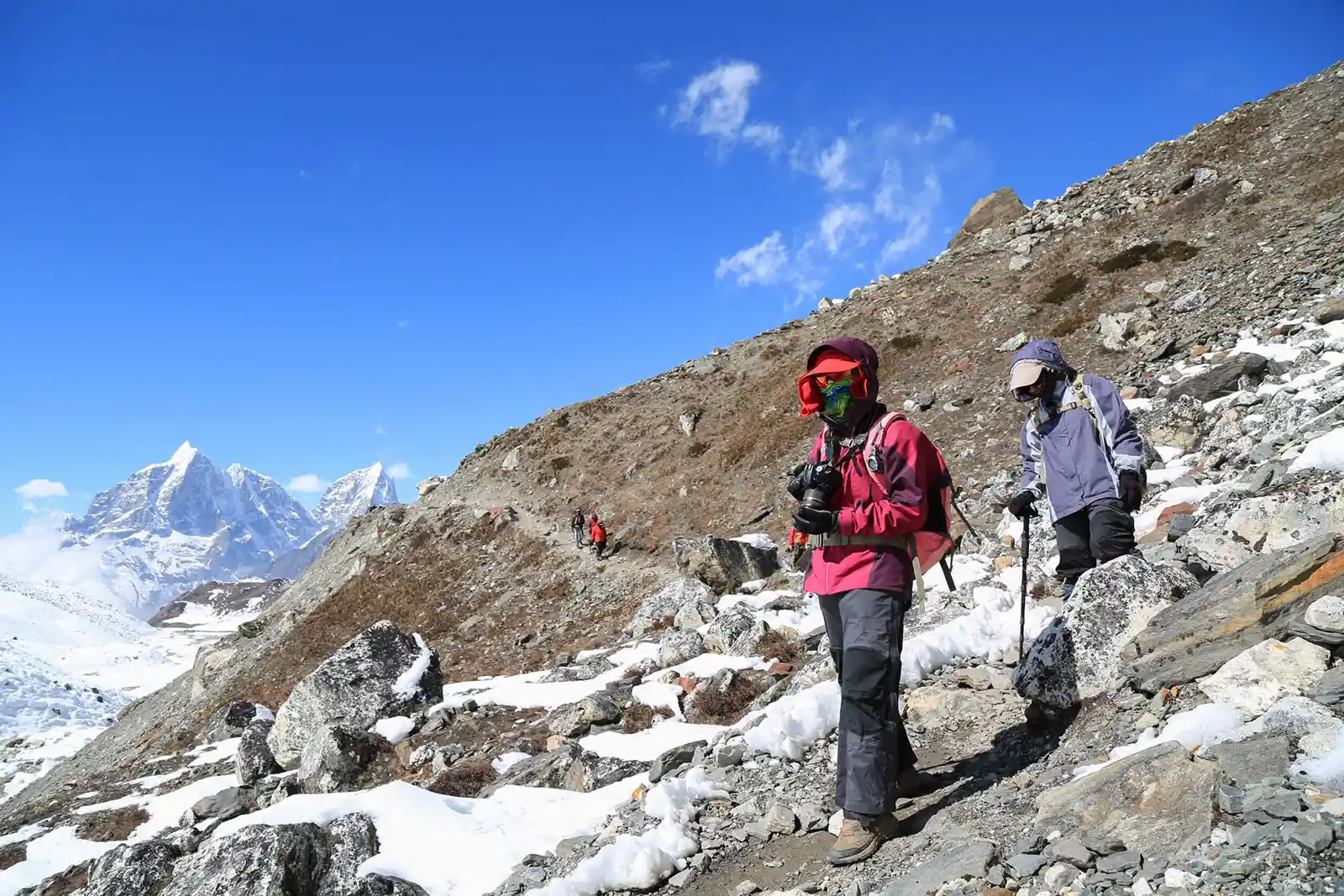
4. Sample itinerary for Everest Base Camp Trek in September
Everest Base Camp Trek in September is an exhilarating adventure, offering trekkers a unique opportunity to witness the majestic Himalayan landscapes. This sample itinerary provides a comprehensive journey overview, including the number of days, distances traveled, and elevation changes.
Day 1: Arrival in Kathmandu
Your adventure begins as you touch down in Kathmandu, Nepal’s capital. Once you’ve completed the customs and immigration procedures, Our committed team will warmly welcome you and assist with your transfer to your designated hotel. Take this day to recover from your journey, adjust to the time zone, and prepare for the exciting trek ahead. If time permits, explore Kathmandu’s vibrant streets, visit historic sites like Swayambhunath (the Monkey Temple), or enjoy the local cuisine.
Day 2: Fly to Lukla, Trek to Phakding
An early morning flight from Kathmandu takes you to Lukla, the starting point for your Everest Base Camp Trek in September. This small Lukla Airport is perched on the edge of the mountains and the flight itself is an adventure, offering stunning views of the Himalayan peaks. Upon arrival in Lukla, you’ll meet your trekking crew and begin the first leg of your journey. The trek on this initial day leads you to Phakding, a serene village along the Dudh Koshi River. This gentle start is designed to allow your body to acclimatize gradually, setting the stage for the rest of your Everest Base Camp Trek in September.
Day 3: Phakding to Namche Bazaar
Crossing suspension bridges and traversing lush forests, you’ll follow the Dudh Koshi River. Your destination is Namche Bazaar, a bustling town with a natural amphitheater. Namche is a trekking hub with markets, shops, and breathtaking views of Everest and Lhotse.
Day 4: Acclimatization Day in Namche Bazaar
Spending a day in Namche Bazaar for proper acclimatization to prevent altitude sickness is essential. This rest day presents an ideal chance to discover the town and its environs. You may visit the Sherpa Cultural Museum for insights into the local culture or hike to the Everest View Hotel, renowned for its panoramic mountain vistas.
Day 5: Namche Bazaar to Tengboche
Leaving Namche on your Everest Base Camp Trek in September, the trail leads through enchanting rhododendron forests and brings you to Tengboche. This village is celebrated for its exquisite Tengboche Monastery, considered one of the most significant in the Khumbu region. It provides an ideal setting to immerse yourself in the local culture while relishing serene mountain views during your Everest Base Camp Trek in September.
Day 6: Tengboche to Dingboche
Today’s journey takes you to Dingboche, another picturesque village amidst stunning Himalayan scenery. The path offers captivating views of Ama Dablam, a striking peak revered by trekkers and climbers alike.
Day 7: Acclimatization Day in Dingboche
You’ll take another rest day in Dingboche to ensure a safe ascent and proper acclimatization. You have the flexibility to utilize this day for relaxation or opt for an invigorating hike to Nagarjun Hill. This vantage point boasts awe-inspiring vistas of the nearby peaks, making it a highly worthwhile adventure.
Day 8: Dingboche to Lobuche
Your trek continues through the captivating Khumbu Valley, leading you to the tranquil village of Lobuche. Here, you’ll find yourself surrounded by towering peaks and immersed in the raw beauty of the Himalayas.
Day 9: Lobuche to Gorak Shep, Everest Base Camp
Today is a highlight of your Everest Base Camp Trek in September as you trek to Gorak Shep, the last teahouse settlement before reaching Everest Base Camp. From Gorak Shep, you’ll continue your adventure to the iconic Everest Base Camp, where you can witness the dramatic Khumbu Icefall and the magnificence of the world’s tallest peak.
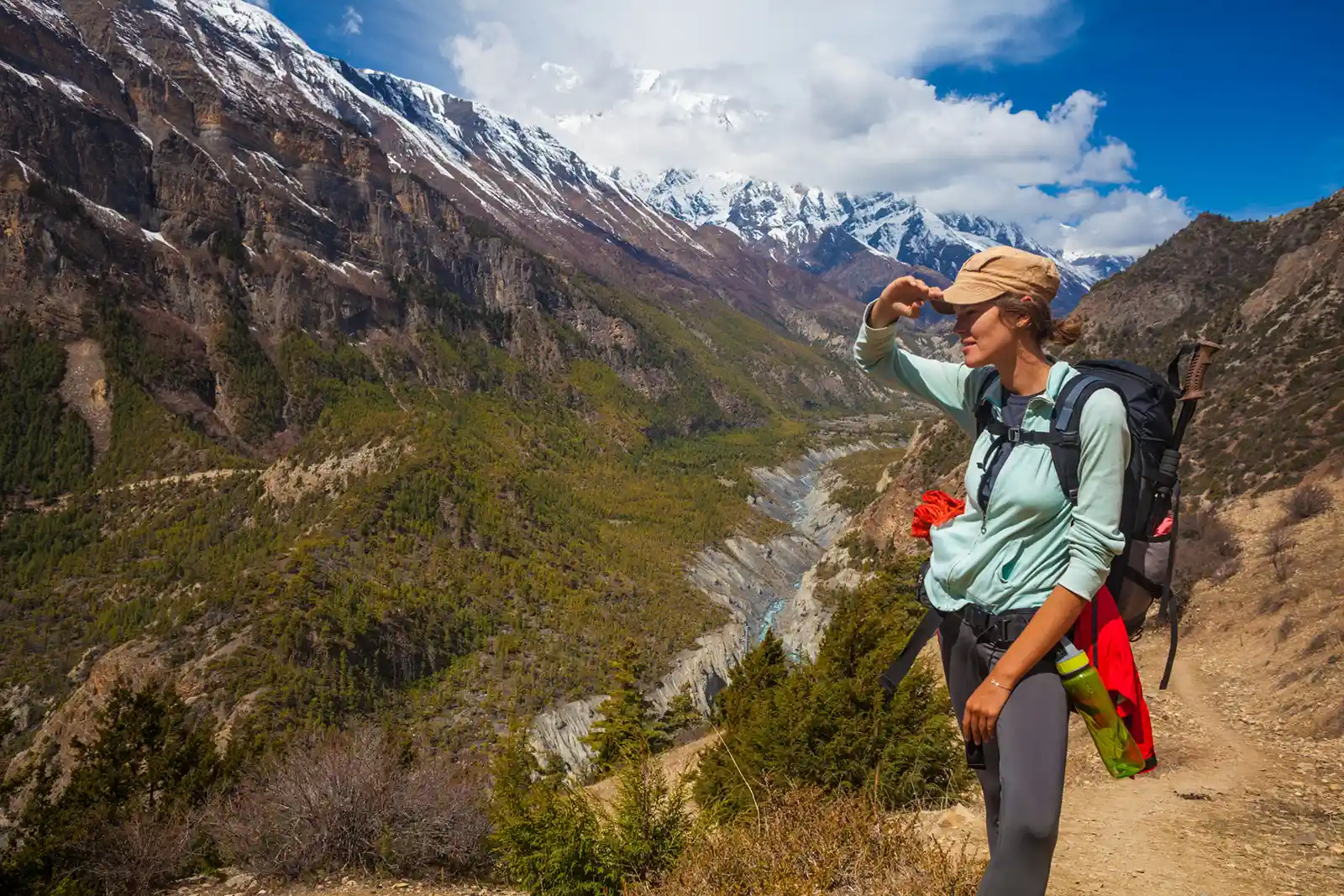
Day 10: Gorak Shep to Kala Patthar, Then Pheriche
In the early morning, you’ll hike to Kala Patthar, a renowned viewpoint offering unparalleled sunrise views of Mount Everest. Afterward, you’ll descend to Pheriche, where you can enjoy a well-deserved rest in a lower-altitude setting.
Day 11: Pheriche to Namche Bazaar
Beginning your descent, you’ll retrace your steps through the picturesque Khumbu Valley, heading back towards Namche Bazaar. Savor the scenery one final time before concluding your trek.
Day 12: Namche Bazaar to Lukla
Your final day of trekking leads you back to Lukla, where you’ll celebrate the successful completion of your journey with your trekking team. Take a moment to reflect on the incredible experiences you’ve had along the way.
Day 13: Fly to Kathmandu
A short but thrilling flight brings you back to Kathmandu. Spend your last night in Nepal’s capital, reminiscing about your Everest Base Camp adventure and exploring the city’s vibrant culture.
Day 14: Departure
Per your flight schedule, you can explore Kathmandu or prepare for your journey home. This marks the end of your unforgettable trek through the heart of the Himalayas.
This comprehensive itinerary ensures a gradual ascent, allowing for acclimatization and an enjoyable experience. Everest Base Camp Trek in September offers the advantage of pleasant weather and clear skies, enhancing your chances of capturing the stunning beauty of the Himalayas in all its glory.
Everest Base Camp Trek for Beginners
Gokyo Cho La Pass Trek
Luxury Everest Base Camp Trek
5. Things to know before the Everest Base Camp Trek in September
Trekking to Everest Base Camp in September offers an exhilarating adventure with clear skies, pleasant weather, and fewer crowds. These favorable conditions make it an ideal time to explore the stunning Himalayas. However, the journey has challenges, including high altitudes and changing weather conditions. To make the most of your trek in September, here are some valuable tips:
1. Acclimatization is Key
While ascending to higher altitudes, allowing your body time to adapt to the reduced oxygen levels is essential. Following the trek itinerary that includes acclimatization days in Namche Bazaar and Dingboche is crucial. These rest days enable your body to adapt gradually, thereby minimizing the risk of altitude sickness. Hydrate well, avoid strenuous activities, and take short hikes to higher elevations during these acclimatization breaks.
2. Stay Hydrated
Proper hydration is essential while trekking at high altitudes. It’s easy to underestimate your fluid needs in the dry, mountainous terrain. Drink plenty of water throughout the day to prevent dehydration, which can exacerbate altitude-related issues. It would help if you considered carrying a reusable water bottle and refilling it at teahouses or streams along the trail. This sustainable practice helps reduce waste and ensures you have access to hydration during your Everest Base Camp Trek in September. To ensure the safety of your drinking water, use water purification tablets or a filtration system. This eco-friendly approach keeps you hydrated while minimizing environmental impact.
3. Dress in Layers
September brings pleasant daytime temperatures, but the nights can be chilly. Layered dressing offers the flexibility to adjust to changing weather conditions. Begin with moisture-wicking base layers to effectively manage sweat, incorporate insulating layers such as fleece for warmth, and complete your attire with a waterproof and windproof outer shell for protection against the elements. This versatile approach ensures comfort and adaptability during your trek. Remember a warm hat, gloves, and a good quality down jacket for warmth during cold mornings and evenings.
4. Protect Yourself from the Sun
The higher you trek, the stronger the sun’s rays become. UV radiation becomes more intense at higher altitudes, elevating the risk of sunburn and snow blindness. To safeguard your eyes and skin, wear sunglasses with UV protection, apply sunscreen with a high SPF rating, and contemplate donning a wide-brimmed hat to shield your face from the sun’s potent rays. These precautions are essential for your well-being during high-altitude treks. Protecting your skin and eyes is crucial during your Everest Base Camp Trek in September.
5. Proper Trekking Gear
Invest in suitable trekking gear, including well-fitted, broken-in hiking boots with ankle support. Quality socks, trekking poles for stability, and a comfortable backpack with a rain cover are essential. Ensure your gear is well-maintained and suited for the conditions to enhance your trekking experience.
6. Listen to Your Body
Trekking at high altitudes can take a toll on your body. Pay close attention to any symptoms of altitude sickness, such as headaches, nausea, dizziness, or fatigue. If you encounter any warning signs, you must descend to lower altitudes promptly and seek medical assistance. Prioritizing your safety is paramount during high-altitude treks, and immediate action can mitigate potentially serious health risks.
7. Travel Insurance
Lastly, having comprehensive travel insurance is non-negotiable. Ensure your insurance policy encompasses emergency evacuations for severe altitude sickness or other emergencies. This modest investment can prove invaluable in challenging circumstances.
By adhering to these recommendations and thorough preparation, you can enhance your enjoyment of the September Everest Base Camp Trek while guaranteeing a secure and unforgettable Himalayan adventure.
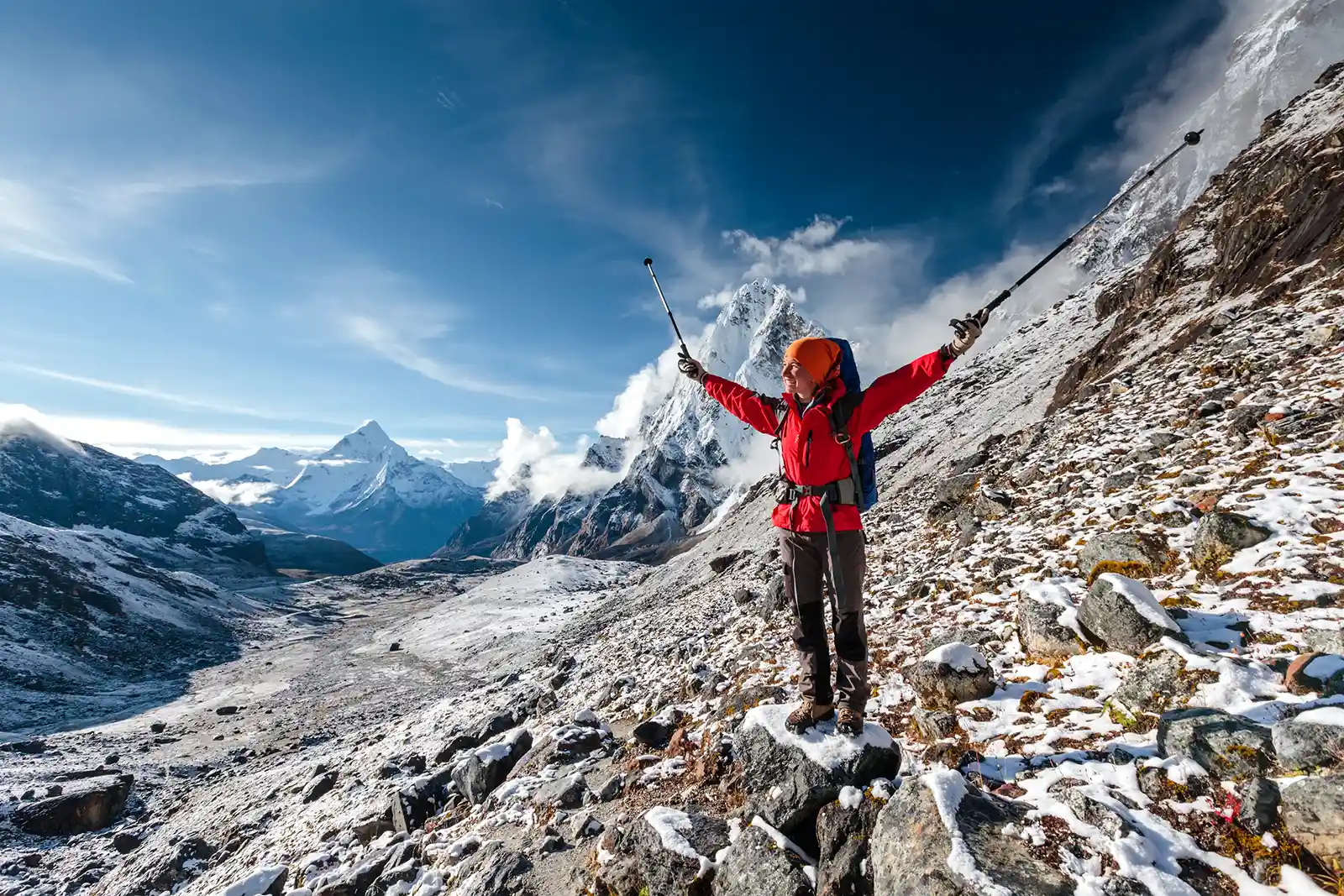
6. Local Culture and Customs During the Everest Base Camp Trek in September
The Everest Base Camp Trek not only treats you to breathtaking natural beauty but also presents a rare chance to deeply engage with the diverse cultural tapestry of the Himalayan region. As you Everest Base Camp Trek in September, you’ll have the chance to engage with the local culture and witness fascinating customs.
Sherpa Culture: The Heart of the Himalayas
The Everest region is primarily home to the Sherpa people, celebrated for their resilience and mountaineering prowess. As you journey through their villages and engage with the locals, you’ll have the privilege of profoundly understanding their warm and inviting culture. Don’t be taken aback if you’re met with the traditional Sherpa greeting, “Tashi Delek,” during your interactions.
Buddhist Influence: Monasteries and Mani Walls
Buddhism is significant in Sherpa culture, and you’ll encounter numerous monasteries and religious monuments on your trek. One notable stop is the Tengboche Monastery, a spiritual center perched on a hill with stunning mountain views. You may witness monks performing rituals or spinning prayer wheels, a common practice to accumulate merit.
Mani walls, inscribed with Buddhist prayers and colorful prayer flags, dot the landscape. It’s customary to walk clockwise around these walls and to keep them on your right as a sign of respect. Remember to never step on the prayer flags, and if you encounter a procession of locals, give way and allow them to pass first.
Local Festivals: Be Part of the Celebrations
September often coincides with local festivals in the Everest region. If your trek aligns with one of these celebrations, consider yourself fortunate. Festivals such as Dumje and Mani Rimdu showcase traditional dances, mask performances, and religious ceremonies. Embrace the opportunity to participate in these festivities, but remember to respect the local customs and traditions.
Teahouse Hospitality: Embrace Local Cuisine
Teahouses play an integral role in the Everest region trekking experience. These lodges are operated by local families who warmly welcome trekkers. While staying in teahouses, embrace the opportunity to savor traditional Sherpa cuisine, such as dal bhat (lentil curry with rice), momo (dumplings), and thukpa (noodle soup). Engaging with the teahouse owners and staff can lead to enriching cultural exchanges and memorable experiences.
Respect Local Customs: Dos and Don’ts
While immersing yourself in the local culture is encouraged, being respectful and considerate is essential. To show respect for local customs, removing your shoes before entering homes or religious buildings is customary. Additionally, it’s advisable to avoid public displays of affection and always seek permission before taking photographs, particularly of individuals. Learning a few essential Nepali phrases, like “Namaste” (hello) and “Dhanyabad” (thank you), can significantly enhance positive interactions and cultural exchange.
By embracing the local culture and customs during your Everest Base Camp Trek in September, you enrich your journey and contribute to preserving these vibrant traditions. Demonstrating respect and appreciation for the local way of life dramatically enriches the authenticity of your Himalayan adventure.
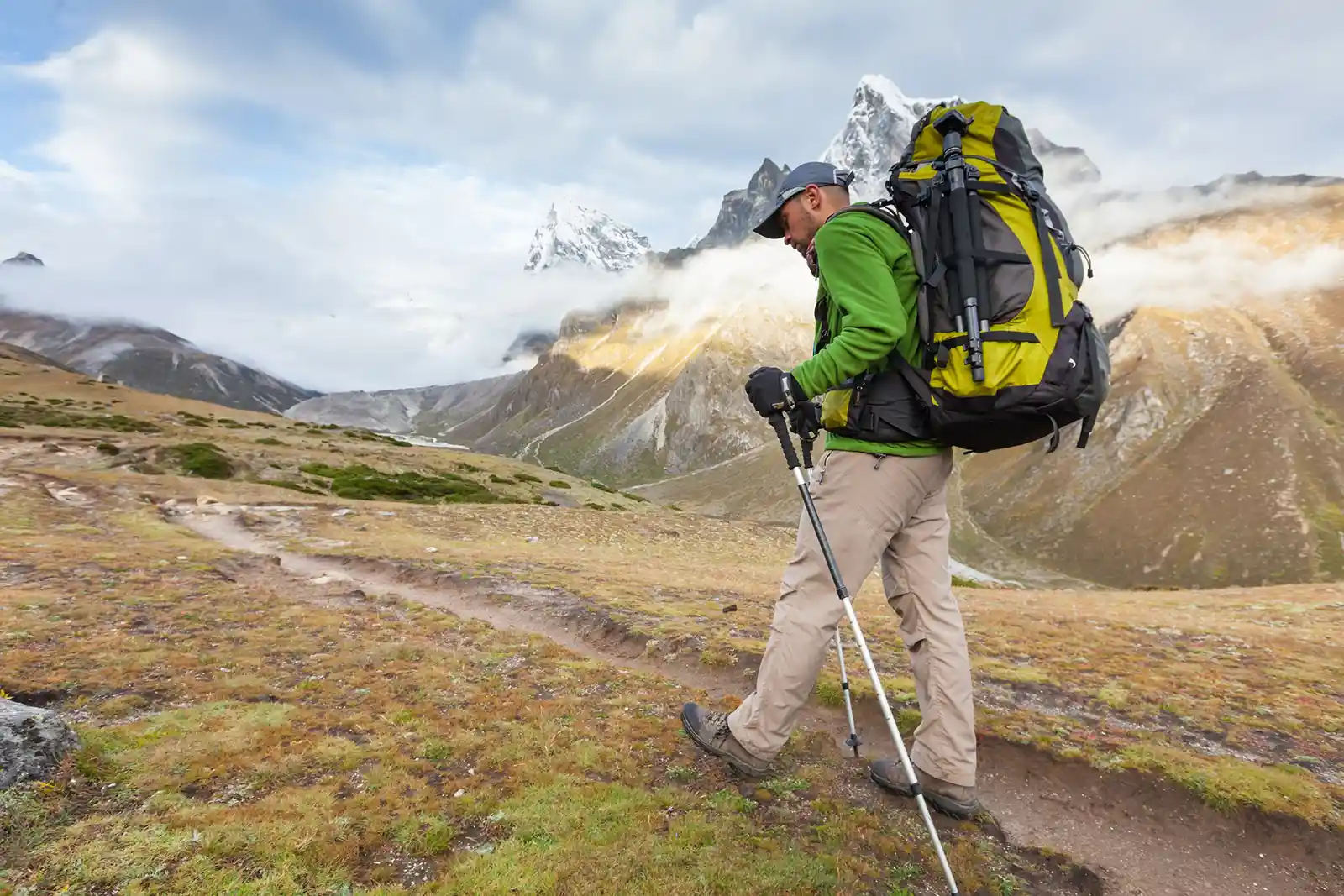
Everest High Pass Trek
Everest View Trek
Jiri to Everest Base Camp Trek
7. Navigating Trekking Dangers: A Cautionary Guide for Everest Base Camp Trek in September
Everest Base Camp Trek in September promises a remarkable adventure filled with awe-inspiring vistas. However, knowing the dangers of high-altitude trekking in the Himalayas is vital. Knowledge and preparation are your best allies in ensuring a safe and memorable journey.
1. Altitude Sickness: A Silent Threat
Altitude, or acute mountain sickness (AMS), is expected when trekking to high elevations. As you ascend to higher altitudes, giving your body the necessary time to adapt to the reduced oxygen levels is essential. The indications and effects of altitude sickness can vary in intensity, from mild discomforts like headaches and nausea to more severe manifestations such as vomiting, breathlessness, and, in extreme cases, fatalities. Among the most critical forms of altitude sickness are high-altitude pulmonary edema (HAPE) and high-altitude cerebral edema (HACE). To mitigate this risk:
– Acclimatize: Plan your itinerary with gradual altitude gains and acclimatization days. Maintain proper hydration, avoid alcohol consumption, and closely monitor your body’s signals. If symptoms occur, descend to a lower elevation immediately.
– Stay Hydrated: Dehydration exacerbates AMS. Ensure you stay well-hydrated by consuming various fluids, including water, herbal teas, and soups. This helps maintain your body’s hydration levels, especially in high-altitude environments. Avoid excessive caffeine and alcohol consumption.
– Medication: Consult your doctor before Everest Base Camp Trek and contemplate carrying preventive medications such as acetazolamide (Diamox).
2. Weather Hazards for Everest Base Camp Trek in September
September generally offers clear skies and pleasant weather for trekking in the Everest region. However, the Himalayan climate can be unpredictable, making rapid changes possible. Be prepared for:
– Cold Nights: While daytime temperatures are mild, nights can be frigid. Pack warm clothing, a good sleeping bag, and thermal layers.
– Monsoon Aftermath: September follows the monsoon season, so be cautious of trail conditions. Rainfall can lead to slippery paths and landslides in certain areas.
3. Avalanches and Landslides: Nature’s Fury
In remote alpine regions like Everest, avalanches and landslides are natural hazards. Although the trekking routes are well-maintained, there is always some risk, particularly in areas like the Khumbu Icefall. To reduce these risks:
– Follow Guides: Local guides and porters have extensive terrain knowledge. Listen to their advice and stay close to the group.
– Check Weather Forecasts: Be aware of weather conditions and forecasts, especially during the monsoon season.
4. River Crossings: Choose Safety Over Speed
During your trek, you’ll encounter several suspension bridges and river crossings. While they are generally safe, exercise caution:
– Cross Slowly: Avoid rushing across bridges and allow other trekkers or yaks to pass first.
– Slippery Paths: Wet rocks and mud can make crossings slippery. Use trekking poles for stability.
5. Health Precautions: Protect Against Illness
September in the Everest region can increase the risk of colds and respiratory illnesses during your Everest Base Camp Trek in September. Carry hand sanitizers and tissues, and maintain good hygiene practices.
You can maximize the benefits of your Everest Base Camp Trek in September and minimize the risks associated with trekking by staying well-informed and taking essential precautions. Remember that your safety should always be the top priority, and it’s okay to adjust your plans or descend if conditions become challenging. Enjoy the adventure while keeping these cautions in mind, and you’ll create lasting memories of your Himalayan expedition.

